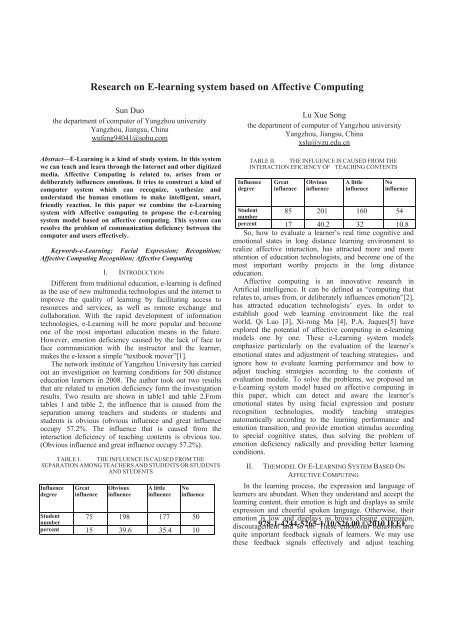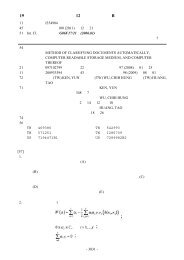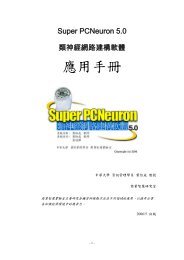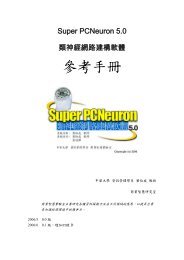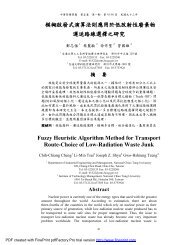Research on E-learning system based on Affective Computing
Research on E-learning system based on Affective Computing
Research on E-learning system based on Affective Computing
You also want an ePaper? Increase the reach of your titles
YUMPU automatically turns print PDFs into web optimized ePapers that Google loves.
<str<strong>on</strong>g>Research</str<strong>on</strong>g> <strong>on</strong> E-<strong>learning</strong> <strong>system</strong> <strong>based</strong> <strong>on</strong> <strong>Affective</strong> <strong>Computing</strong>Sun Duothe department of computer of Yangzhou universityYangzhou, Jiangsu, Chinawufeng94041@sohu.comAbstract—E-Learning is a kind of study <strong>system</strong>. In this <strong>system</strong>we can teach and learn through the Internet and other digitizedmedia. <strong>Affective</strong> <strong>Computing</strong> is related to, arises from ordeliberately influences emoti<strong>on</strong>s. It tries to c<strong>on</strong>struct a kind ofcomputer <strong>system</strong> which can recognize, synthesize andunderstand the human emoti<strong>on</strong>s to make intelligent, smart,friendly reacti<strong>on</strong>. In this paper we combine the e-Learning<strong>system</strong> with <strong>Affective</strong> computing to propose the e-Learning<strong>system</strong> model <strong>based</strong> <strong>on</strong> affective computing. This <strong>system</strong> canresolve the problem of communicati<strong>on</strong> deficiency between thecomputer and users effectively.Keywords-e-Learning; Facial Expressi<strong>on</strong>; Recogniti<strong>on</strong>;<strong>Affective</strong> <strong>Computing</strong> Recogniti<strong>on</strong>; <strong>Affective</strong> <strong>Computing</strong>I. INTRODUCTIONDifferent from traditi<strong>on</strong>al educati<strong>on</strong>, e-<strong>learning</strong> is definedas the use of new multimedia technologies and the internet toimprove the quality of <strong>learning</strong> by facilitating access toresources and services, as well as remote exchange andcollaborati<strong>on</strong>. With the rapid development of informati<strong>on</strong>technologies, e-Learning will be more popular and become<strong>on</strong>e of the most important educati<strong>on</strong> means in the future.However, emoti<strong>on</strong> deficiency caused by the lack of face toface communicati<strong>on</strong> with the instructor and the learner,makes the e-less<strong>on</strong> a simple “textbook mover”[1].The network institute of Yangzhou University has carriedout an investigati<strong>on</strong> <strong>on</strong> <strong>learning</strong> c<strong>on</strong>diti<strong>on</strong>s for 500 distanceeducati<strong>on</strong> learners in 2008. The author took out two resultsthat are related to emoti<strong>on</strong> deficiency form the investigati<strong>on</strong>results. Two results are shown in table1 and table 2.Fromtables 1 and table 2, the influence that is caused from theseparati<strong>on</strong> am<strong>on</strong>g teachers and students or students andstudents is obvious (obvious influence and great influenceoccupy 57.2%. The influence that is caused from theinteracti<strong>on</strong> deficiency of teaching c<strong>on</strong>tents is obvious too.(Obvious influence and great influence occupy 57.2%).TABLE I. THE INFLUENCE IS CAUSED FROM THESEPARATION AMONG TEACHERS AND STUDENTS OR STUDENTSAND STUDENTSInfluencedegreeGreatinfluenceObviousinfluenceA littleinfluenceNoinfluenceStudentnumber75 198 177 50percent 15 39.6 35.4 10Lu Xue S<strong>on</strong>gthe department of computer of Yangzhou universityYangzhou, Jiangsu, Chinaxslu@yzu.edu.cnTABLE II. THE INFLUENCE IS CAUSED FROM THEINTERACTION EFICIENCY OF TEACHING CONTENTSInfluencedegreeGreatinfluenceObviousinfluenceA littleinfluenceNoinfluenceStudent 85 201 160 54numberpercent 17 40.2 32 10.8So, how to evaluate a learner’s real time cognitive andemoti<strong>on</strong>al states in l<strong>on</strong>g distance <strong>learning</strong> envir<strong>on</strong>ment torealize affective interacti<strong>on</strong>, has attracted more and moreattenti<strong>on</strong> of educati<strong>on</strong> technologists, and become <strong>on</strong>e of themost important worthy projects in the l<strong>on</strong>g distanceeducati<strong>on</strong>.<strong>Affective</strong> computing is an innovative research inArtificial intelligence. It can be defined as “computing thatrelates to, arises from, or deliberately influences emoti<strong>on</strong>”[2],has attracted educati<strong>on</strong> technologists’ eyes. In order toestablish good web <strong>learning</strong> envir<strong>on</strong>ment like the realworld, Qi Luo [3], Xi-r<strong>on</strong>g Ma [4], P.A. Jaques[5] haveexplored the potential of affective computing in e-<strong>learning</strong>models <strong>on</strong>e by <strong>on</strong>e. These e-Learning <strong>system</strong> modelsemphasize particularly <strong>on</strong> the evaluati<strong>on</strong> of the learner’semoti<strong>on</strong>al states and adjustment of teaching strategiesandignore how to evaluate <strong>learning</strong> performance and how toadjust teaching strategies according to the c<strong>on</strong>tents ofevaluati<strong>on</strong> module. To solve the problems, we proposed ane-Learning <strong>system</strong> model <strong>based</strong> <strong>on</strong> affective computing inthis paper, which can detect and aware the learner’semoti<strong>on</strong>al states by using facial expressi<strong>on</strong> and posturerecogniti<strong>on</strong> technologies, modify teaching strategiesautomatically according to the <strong>learning</strong> performance andemoti<strong>on</strong> transiti<strong>on</strong>, and provide emoti<strong>on</strong> stimulus accordingto special cognitive states, thus solving the problem ofemoti<strong>on</strong> deficiency radically and providing better <strong>learning</strong>c<strong>on</strong>diti<strong>on</strong>s.II. THEMODEL OF E-LEARNING SYSTEM BASED ONAFFECTIVE COMPUTINGIn the <strong>learning</strong> process, the expressi<strong>on</strong> and language oflearners are abundant. When they understand and accept the<strong>learning</strong> c<strong>on</strong>tent, their emoti<strong>on</strong> is high and displays as smileexpressi<strong>on</strong> _____________________________________and cheerful spoken language. Otherwise, theiremoti<strong>on</strong> is low and displays as brows closing expressi<strong>on</strong>,discouragement 978-1-4244-5265-1/10/$26.00 and so <strong>on</strong>. These emoti<strong>on</strong>al ©2010 behaviors IEEEarequite important feedback signals of learners. We may usethese feedback signals effectively and adjust teaching
strategies to serve pers<strong>on</strong>alized <strong>learning</strong>. The model ofE-<strong>learning</strong> <strong>system</strong> <strong>based</strong> <strong>on</strong> affective computing is Fig.1..TABLE III.The e-Learning System Model Based <strong>on</strong> <strong>Affective</strong><strong>Computing</strong>As interface between user and computer, this part ismainly resp<strong>on</strong>sible for the identity of the user to verify theinformati<strong>on</strong>, collecti<strong>on</strong> of user feedback, showing coursesdealing with informati<strong>on</strong> and analysis of user feedbackinformati<strong>on</strong>. User informati<strong>on</strong> input includes interface agents,affective computing server and user accounts database.<strong>Affective</strong> computing terminals in agent interface andaffective computing server are characteristics in thise-Learning <strong>system</strong> model. In the <strong>learning</strong> process, users arem<strong>on</strong>itored by affective computing terminals real-time, andthe informati<strong>on</strong> gathered about facial expressi<strong>on</strong>, speech, andother messages be passed to affective computing server.After a period of <strong>learning</strong>, the types and proporti<strong>on</strong> of facialexpressi<strong>on</strong>s, speech appeared are automatic calculated. Userscan fill out a questi<strong>on</strong>naire survey to take the initiative toform a study evaluati<strong>on</strong> to adjust the pace of <strong>learning</strong>; The<strong>system</strong> forms a final evaluati<strong>on</strong> with the support of cognitivepsychology automatically to feedback.In <strong>system</strong>s, guidance <strong>learning</strong> modules get the feedbackinformati<strong>on</strong> mainly <strong>based</strong> "input user informati<strong>on</strong>" forstudents to find suitable courses. These are composed ofthree parts, which are pers<strong>on</strong>alized guidance from someagents, user database and curriculum database. Pers<strong>on</strong>alizedguidance agent is c<strong>on</strong>stituted of feedback agent andrecommendable <strong>learning</strong> agents, and feedback is the mainagent resp<strong>on</strong>sible for the results which passed frominformati<strong>on</strong> from the user, such as <strong>learning</strong> evaluati<strong>on</strong>, andthen c<strong>on</strong>vert into the corresp<strong>on</strong>ding evaluati<strong>on</strong> parameters,moreover carry out the previous record of users <strong>learning</strong>from the user informati<strong>on</strong> database, and transfer agents ofrecommending courses; study recommended agents acceptparameters and record of <strong>learning</strong>, and,accordingly adjusted, from the courses informati<strong>on</strong>database search suitable for the level of user <strong>learning</strong>materials to the transfer agent interface, so that students canbe adjusted progress in time.III.REALIZATION OF KEY TECHNOLOGIESFacial expressi<strong>on</strong> recogniti<strong>on</strong>Human expressi<strong>on</strong> scientists Ekman and Friesen havedefined six kinds of basic expressi<strong>on</strong>, such as happy, sad,surprise, fear, anger, and disgust as well as 33 kinds ofdifferent expressi<strong>on</strong>s[6].Classificati<strong>on</strong> and recogniti<strong>on</strong> ofbasic expressi<strong>on</strong>s are proposed in the paper. First, facialcharacteristics are extracted.Supposed the distance and change am<strong>on</strong>g parts in the faceare measured by Euclidean distance. Six parameters of<strong>on</strong>e-dimensi<strong>on</strong>al vector have defined as a face expressi<strong>on</strong>model X=(d1, d2, d3, d4, d5, d6), where d1 is the distancebetween two eyebrows, d2 is the distance between upper eyeside and nether eye side, d3 is the distance between eyebrowand nether eye side, d4 is the mouth high, d5 is the mouthwidth, d6 is the distance between mouth corner and upper lip.Therefore, an expressi<strong>on</strong> is a spot in six-dimensi<strong>on</strong>al space,and the expressi<strong>on</strong> is recognized though judging Euclideandistance in six-dimensi<strong>on</strong>al space.Adjusting teaching strategiesThe change of learners’ emoti<strong>on</strong> is more complex in the<strong>learning</strong> process. The learner c<strong>on</strong>tacts with a new knowledgepoint, two kinds of attitudes such as interested state andindifferent state may appear. With the <strong>learning</strong> processadvancing, learner's emoti<strong>on</strong> is changed. For instance, thelearner has an idea to solve this problem. If the learnerdefeated repeatedly, he will suspect himself and changes intothe depressi<strong>on</strong> state,this kind of state is disadvantageous to<strong>learning</strong>. The <strong>system</strong> should apperceive this kind ofemoti<strong>on</strong>al change and carry <strong>on</strong> emoti<strong>on</strong> intervening, whichlet him turn to self-c<strong>on</strong>fident state. When he c<strong>on</strong>tacts with anext new knowledge point, the emoti<strong>on</strong> turn to the state ofsurprise and puzzle too.Teaching strategies are adjusted according to student'semoti<strong>on</strong> dynamically though producti<strong>on</strong> rules. We neglectother influencing factors and take the <strong>learning</strong> style as theexample.IV. CONCLUSIONIn this paper, through the analysis of each module showsthat the e-<strong>learning</strong> <strong>system</strong> <strong>based</strong> <strong>on</strong> affective computingcan manage and track real-time <strong>learning</strong> process, evaluate<strong>learning</strong> effect, set down different <strong>learning</strong> schemes fordifferent learners, provide feedbacks and evaluati<strong>on</strong>s in time,thus setting individual <strong>learning</strong> c<strong>on</strong>diti<strong>on</strong>s, inspiring <strong>learning</strong>interest, enhancing <strong>learning</strong> c<strong>on</strong>sciousness and <strong>learning</strong>effect, which will result in improvement of teaching quality.With the development of network technology, e-<strong>learning</strong><strong>system</strong>s <strong>based</strong> <strong>on</strong> affective computing would have morewider developing potential and applicati<strong>on</strong> value, and wouldbe developed quickly in the near future, thus bringing goodsocial benefits and tremendous ec<strong>on</strong>omic benefits forl<strong>on</strong>g-distance educati<strong>on</strong>.ACKNOWLEDGEMENTThe author thanks her colleagues for their helpfuldiscussi<strong>on</strong>.
REFERENCES[1] LiuJianming, WangJincai. “The distance educati<strong>on</strong> <strong>system</strong> <strong>based</strong> <strong>on</strong>affective computing”. China medical educati<strong>on</strong> technology, 2008,22(1): 67-69[2] LuoQi, WanLiy<strong>on</strong>g, WuYanwen. “Applicati<strong>on</strong> of affective computingin e-<strong>learning</strong> <strong>system</strong>”. Open educati<strong>on</strong> research, 2006, 12(3): 80-83[3] MaXi-r<strong>on</strong>g, Wang,Zhi-liang. “Study <strong>on</strong> modeling of emoti<strong>on</strong>interacti<strong>on</strong> in l<strong>on</strong>g-distance educati<strong>on</strong>”.Computer science, 2005, 32(9):182-184[4] Picard, R.W., <strong>Affective</strong> computing. The MIT Press,Cambridge MA,1997[5] P. A. Jaques and R.M. Vicari. “A BDI approach to inferstudent’semoti<strong>on</strong>s in an intelligent <strong>learning</strong> envir<strong>on</strong>ment”. Computers &Educati<strong>on</strong>, 2007, 49(2): 360-384[6] S. R. Marquardt. (2003). MBA website. [Online].Available:http://www.beautyanalysis.com


